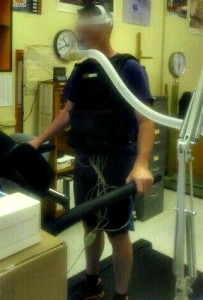Last week I discussed how important it is for firefighters to undergo regular fitness testing. Yet, not every department can afford to hire someone like me to conduct these tests. So I’m giving you a few simple tests to assess yourself. Click here to see how to test your own muscular fitness and flexibility.
Here’s how to assess your aerobic capacity using a running test.
Want a firefighter specific walking test? Scroll down to find out how to get it.
- Start by walking on the treadmill for 3 minutes at a pace of 3.0 mph. This is a warm-up but counts toward your final time.
- When the clock on the treadmill says 3:00, increase the speed to 4.5 mph.
- At minute 4:00, increase the incline to 2%.
- At minute 5:00, increase the speed to 5.0 mph.
- Every minute afterward, alternate increasing the speed by 0.5 mph or the incline by 2%. The chart below shows the protocol, you may want to print it.
- Run as long as you are able and record the time at which you stopped. Be sure to walk for 3 minutes to cool down.
Source: IAFF Wellness Fitness Initiative
How to interpret your results
Aerobic capacity is actually quantified by measuring a person’s maximal oxygen uptake, or their “VO2max,” in a research lab.
This test gives you a formula to predict your VO2max (+/- 3.7) based on the time you achieved on the protocol, and your size. You just need to do a teeny bit of calculation. Follow these steps to calculate your predicted VO2max:
1. Convert your time to number of minutes. For example, 12:30 would be 12.5 minutes.
2. Calculate your Body Mass Index (BMI):
If using metric system, BMI = weight in Kg / (height in meters)2
If using US units, BMI = weight in lb / (height in inches)2 x 703
3. Insert your values from steps 1 and 2 into this formula:
VO2max = 14.821 + (time x 2.874) + (BMI x -0.242)
How good is your VO2max?
Research suggests that firefighters should achieve a VO2max of at least 42 in order to perform strenuous duties safely, without risk for heart attack. Firefighters with a very low aerobic capacity are at the greatest risk of experiencing a cardiac event.
How does your VO2max compare to others?
This chart shows how your aerobic capacity compares to the hundreds of firefighters I’ve tested over the past 7 years.
| age | VO2max | |
| 20-29 | 47.3 | |
| 30-39 | 44.9 | |
| 40-49 | 42.8 | |
| 50-59 | 43.0 | |
These charts show how your aerobic capacity compares to the general population.
Men:
| Percentile | age 20-29 | age 30-39 | age 40-49 | age 50-59 | ||||
| 90th | 55.1 | 52.1 | 50.6 | 49.0 | ||||
| 80th | 52.1 | 50.6 | 49.0 | 44.2 | ||||
| 70th | 49.0 | 47.4 | 45.8 | 41.0 | ||||
| 60th | 47.4 | 44.2 | 44.2 | 39.4 | ||||
| 50th | 44.2 | 42.6 | 41.0 | 37.8 | ||||
| 40th | 42.6 | 41.0 | 39.4 | 36.2 | ||||
| 30th | 41.0 | 39.4 | 36.2 | 34.6 | ||||
| 20th | 37.8 | 36.2 | 34.6 | 31.4 | ||||
| 10th | 34.6 | 33.0 | 31.4 | 29.9 | ||||
Women:
| Percentile | age 20-29 | age 30-39 | age 40-49 | age 50-59 | ||||
| 90th | 49.0 | 45.8 | 42.6 | 37.8 | ||||
| 80th | 44.2 | 41.0 | 39.4 | 34.6 | ||||
| 70th | 41.0 | 39.4 | 36.2 | 33.0 | ||||
| 60th | 39.4 | 36.2 | 34.6 | 31.4 | ||||
| 50th | 37.8 | 34.6 | 33.0 | 29.9 | ||||
| 40th | 36.2 | 33.0 | 31.4 | 28.3 | ||||
| 30th | 33.0 | 31.4 | 29.9 | 26.7 | ||||
| 20th | 31.4 | 29.9 | 28.3 | 25.1 | ||||
| 10th | 28.3 | 26.7 | 25.1 | 21.9 | ||||
Source: American College of Sports Medicine Guidelines for Exercise Testing
Want to assess your aerobic capacity using a firefighter specific walking test?
I created a maximal treadmill test that is scientifically validated to predict firefighters’ aerobic capacity and inform them if they’re at risk for heart attack. This test, which was published in a scientific journal, is much more representative of the job of firefighting than a running test. Firefighters walk briskly up an increasingly higher incline while wearing a weighted vest. It is very easy to learn to do and subscribers to my Firefighter Wellness Training get the instructions. Click here to learn more about my Firefighter Wellness Training.
If you’re not on my list to get more health tips like these, enter your name and email below.





I had my VO2 max done about a year ago on a treadmill (using the nose clip, gas analysis, etc.) and scored a 52. In doing the VO2 in the manner you have described, I score a 34. How come such a difference in numbers?
Hey Stephanie, there is an error margin of 3.7 when doing the predicted test but you’re right, it shouldn’t be that different unless your aerobic capacity declined a lot in the past year. Are you including your warm-up minutes in your final time? (you’re suppose to). If you want to send me your final time, height and weight to karlie@fitfordutyconsulting.com I will double check the numbers for you.
What test would you recommend for departments that dont have a treadmill or are trying to test big groups?
Thanks.